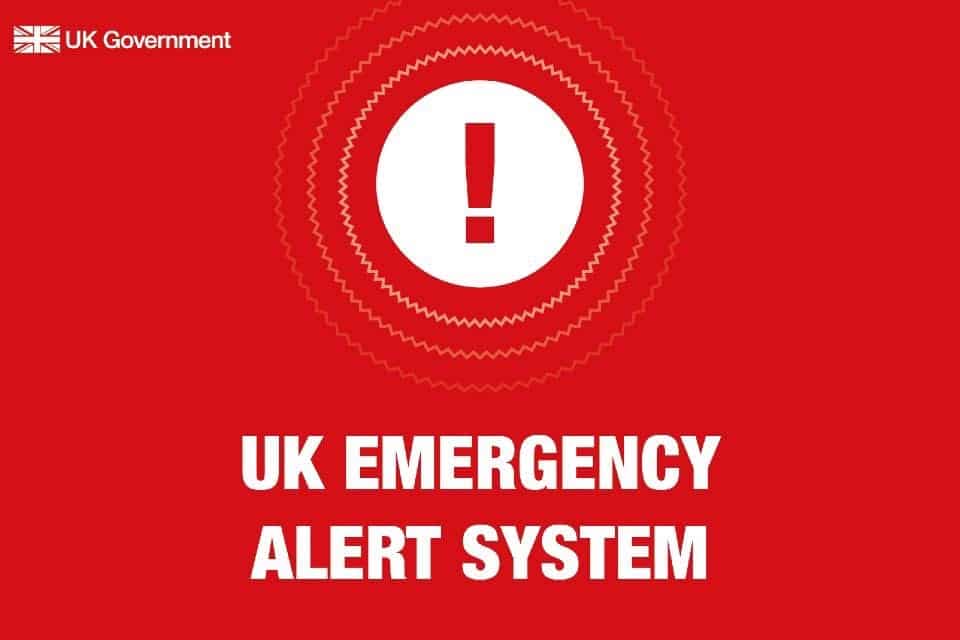Emergency Alert to be sent to mobile phones across the UK in the second ever national test of the system.
Alert will sound at around 3pm on Sunday 7 September.
Test comes as the government publishes a Resilience Action Plan with new steps to secure the country and deliver the Plan for Change.
Mobile phones in the UK will be sent a test Emergency Alert at around 15:00 on Sunday 7th September 2025, as part of plans to strengthen the country’s preparedness.
The Emergency Alerts system is used to warn if there’s a danger to life nearby, including extreme weather. It allows vital information and advice to be sent to people rapidly in an emergency.
During the test, mobile phones will vibrate and make a loud siren sound for roughly ten seconds, even if they are set to silent. A message will also appear on phone screens, making it clear the alert is only a test. There are approximately 87 million mobile phones in the UK.
The test will be just the second of its kind and follows a government commitment to test the system regularly to make sure it works optimally and familiarise the public with the alerts. This is in line with standard practice in other countries, such as Japan and the USA.
Ahead of the national test, the government will be running a public information campaign to notify people that the test is taking place, including communications targeted at vulnerable groups, such as victims of domestic abuse. The campaign will also feature products in British Sign Language.
Pat McFadden, Chancellor of the Duchy of Lancaster, said:
“Emergency Alerts have the potential to save lives, allowing us to share essential information rapidly in emergency situations including extreme storms. Just like the fire alarm in your house, it’s important we test the system so that we know it will work if we need it.
“This test is part of our action plan to build resilience across the whole country and secure the nation under the Plan for Change – from the £1 billion we’re investing in a new network of National Biosecurity Centres to the £4.2 billion we’re investing to build a new generation of flood defences to protect local communities.”
Since the first national test of the Emergency Alerts system in April 2023, five alerts have been sent, including during major storms when lives were at risk.
The largest ever use of the system saw approximately 4.5 million people in Scotland and Northern Ireland receive an alert during Storm Éowyn in January 2025, after a red weather warning was issued, meaning there was a risk to life.
Approximately 3.5 million people across Wales and the South West of England received an alert during Storm Darragh in December 2024. The storm went on to kill two people.
Other activations have included when an unexploded World War II bomb was discovered in Plymouth, as well as during localised flash flooding in Cumbria and Leicestershire.
The news comes as the Chancellor of the Duchy of Lancaster, Pat McFadden, unveils a new Resilience Action Plan to improve the way the government prepares for and responds to emergencies. The Resilience Action Plan, to be published on Tuesday, sets out:
The government will raise awareness of GOV.UK/PREPARE, which gives information on simple and effective steps people can take to be more prepared for an emergency.
The Department for Science, Innovation and Technology is investing £370 million to better secure the UK’s telecommunications networks through research and investment in new technology and infrastructure.
The National Situation Centre and the Devolved Governments are going to sign a data sharing MoU to ensure that every nation in the UK has the best available data to prepare and respond to crises.
The government will also publish an update on the implementation of the 2023 Biological Security Strategy on Tuesday, outlining further action being taken to secure the country from biological risks, including:
£15m funding will be made available in FY25/26 via the Integrated Security Fund to help strengthen biosecurity capability across government
A Pandemic Preparedness and Response Research Framework will be published by the Department for Health and Social Care, helping to coordinate scientific research to prepare for the next pandemic.
The Defence Science and Technology Laboratory (Dstl) will invest £1m through the Defence and Security Accelerator (DASA) across projects with Kromek Group, Cambridge Consultants Ltd, University of Glasgow, Queens University Belfast and Cardiff University to develop new, novel methods to detect and attribute biological incidents.
A new network of National Biosecurity Centres, announced in the National Security Strategy and backed by over £1.3 billion of investment, will bolster the UK’s defences against biological incidents, accidents and attacks.
The announcements follow the publication of the National Security Strategy last month, which set out the largest sustained increase in national security spending since the Cold War, as the government takes more action to secure the county.
In June, DEFRA announced it was investing £4.2 billion in new flood defences to keep communities safe.
This Autumn will also see the Department for Health and Social Care and the UK Health Security Agency deliver the largest pandemic exercise in the country’s history.
For the first time, the government can reveal that preparations for pandemic exercise (‘Exercise Pegasus’) are already underway. Exercise Alkarab, an initial simulation, took place in May with more than 150 participants from across the UK, including health officials and government ministers.

